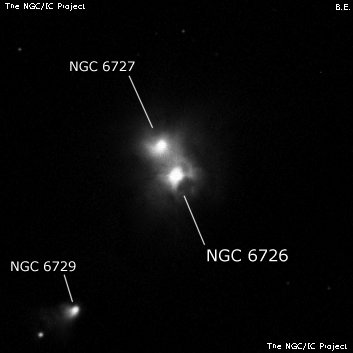
Julius Schmidt discovered NGC 6726, along with NGC 6727, in October 1860 with the 6.2" refractor at the Athens Observatory. He made a second observation on 8 Feb 1861 (also NGC 6729) that was published in 1865 (AN 65, 263) and mentioned it was first seen in 1860. Albert Marth rediscovered this bright reflection nebula on 2 Jul 1864 and noted "* 7m in a F, pL, white envelope." As these bright reflection nebulae are only 30' SE of the showpiece globular NGC 6723, it's surprising they were missed by John Herschel.
200/250mm - 8" (7/31/81): two fairly bright, round patches in contact surrounding a wide pair (B 957) consisting of a mag 7.2 star and the variable TY CrA (8.8-12.5) at 58". A closer double star BRS 14 (6.5/7.0 at 13") to the SW. In a stunning low power field with NGC 6729 and globular cluster NGC 6723.
400/500mm - 17.5" (7/29/92): two bright, round nebulae oriented SSW-NNE: The SSW component (NGC 6726) surrounds a mag 7.2 star and the NNE component (NGC 6727) surrounds the variable star TY Coronae Australis (mag 9.5-10). Both nebulae are roughly 1.5' diameter and in contact with overlapping halos. The evenly matched double star BRS 14 = 6.6/6.8 at 13" is 13' SW. Very unusual dark field is void of stars and set in a striking low power field with nebula NGC 6729 and globular NGC 6723.
Notes by Steve Gottlieb